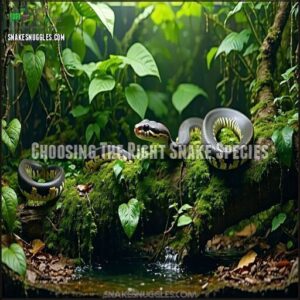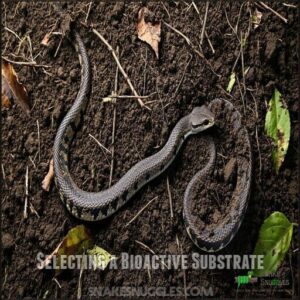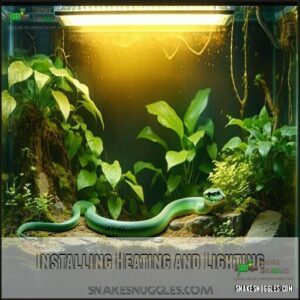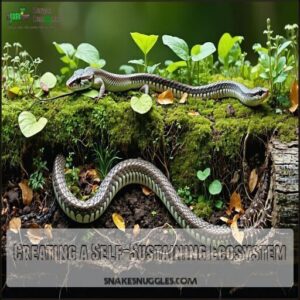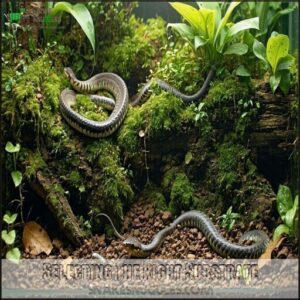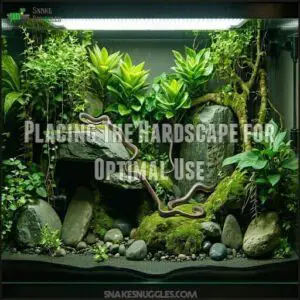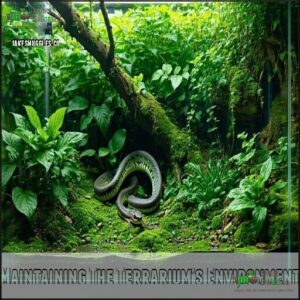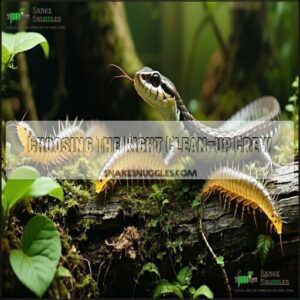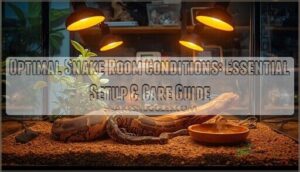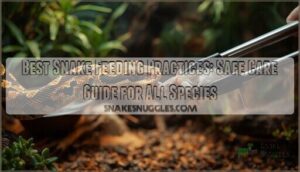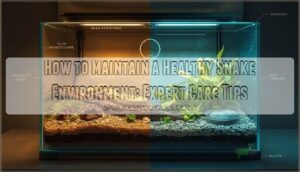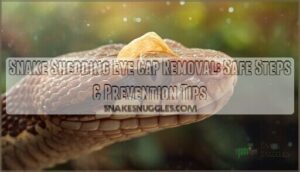This site is supported by our readers. We may earn a commission, at no cost to you, if you purchase through links.
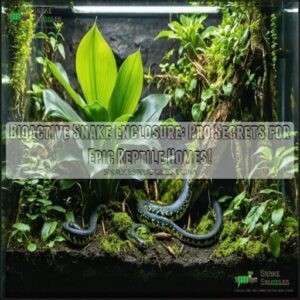 Building a bioactive snake enclosure isn’t rocket science, but it does require some strategic planning.
Building a bioactive snake enclosure isn’t rocket science, but it does require some strategic planning.
You’ll want to start with a solid drainage layer using clay pellets or gravel to prevent water stagnation. Choose a substrate mix that mimics your snake’s natural habitat, incorporating organic materials like coconut fiber and bark.
Don’t forget to add a cleanup crew of springtails and isopods to manage waste and keep things balanced.
Live plants aren’t just decorative—they help regulate humidity and provide enriching hiding spots. The key is creating a mini-ecosystem that feels like home for your scaly friend.
Ready to transform that terrarium into a snake paradise?
Table Of Contents
- Key Takeaways
- Choosing The Right Snake Species
- Setting Up The Terrarium
- Creating a Self-Sustaining Ecosystem
- Selecting The Right Substrate
- Adding Live Plants to The Terrarium
- Building The Terrarium’s Hardscape
- Maintaining The Terrarium’s Environment
- Choosing The Right Clean-up Crew
- Final Considerations for The Terrarium
- Enjoying Your New Bioactive Snake Enclosure
- Frequently Asked Questions (FAQs)
- How to build a bioactive snake enclosure?
- How can a bioactive snake enclosure help a picky reptile?
- Should you build a bioactive enclosure?
- How do I set up a bioactive snake terrarium?
- Do you need a bioactive reptile enclosure?
- Can snakes live in bioactive enclosures?
- What is a bioactive enclosure?
- Does a bioactive enclosure need to support living organisms?
- How do I choose a bioactive enclosure?
- How to make a bioactive enclosure for a snake?
- Conclusion
Key Takeaways
- You’ll need a strategic layering approach when building your snake’s bioactive enclosure, starting with a proper drainage layer, nutrient-rich substrate, and live plants that create a self-sustaining ecosystem.
- Choose your snake species carefully, with beginner-friendly options like ball pythons and corn snakes that adapt well to bioactive environments and have manageable husbandry requirements.
- Your cleanup crew of springtails and isopods are essential microorganisms that break down waste, prevent odors, and maintain a pristine habitat, transforming your terrarium into a living, breathing system.
- Consistent monitoring and subtle adjustments are crucial for maintaining your bioactive enclosure’s health, which means tracking temperature, humidity, substrate conditions, and your snake’s behavior to ensure a stable, enriching environment.
Choosing The Right Snake Species
When building a bioactive snake enclosure, picking the right snake species can make or break your reptile habitat adventure.
Your perfect snake companion depends on factors like temperament, size, and environmental needs, with beginner-friendly options like ball pythons and corn snakes offering an excellent starting point for new reptile enthusiasts.
Ball Pythons as a Good Choice
If you’re new to snake keeping, ball pythons are the perfect starter reptile. These docile creatures thrive in bioactive snake enclosures, offering beginners an easy path to exotic pet ownership.
Discover the joy of snake keeping with gentle ball pythons—your gateway to exotic pet paradise!
Their manageable size and gentle temperament make them ideal for first-time snake owners. With simple husbandry requirements, ball pythons adapt beautifully to carefully crafted habitats.
By providing a rich, naturalistic bioactive substrate and thoughtful care, you’ll create a comfortable home where your scaly friend can truly flourish.
Corn Snakes and Their Adaptability
After mastering ball python basics, corn snakes emerge as the ultimate beginner-friendly snake for your bioactive enclosure adventure.
These adaptable reptiles bring excitement to snake habitat design with their unique characteristics:
Corn snakes: nature’s palette of slithery charm, ready to transform your reptile habitat into a living masterpiece.
- Their docile temperament makes handling a breeze
- Easily managed humidity requirements simplify care
- Stunning morph variations keep things visually interesting
Corn snakes thrive in carefully crafted environments, offering beginner snake enthusiasts a forgiving introduction to bioactive substrate management.
With their slender bodies and remarkable climbing abilities, they’ll transform your enclosure into a living, breathing ecosystem that’s both scientifically fascinating and visually enchanting.
Western Hognose Snakes and Their Quirks
Discover the realm of Western hognose snakes, where nose-twitching drama meets master bluffing.
These pint-sized performers sport an upturned snout perfect for digging and a personality that’ll keep you entertained.
From their sandy brown coloration to their elaborate death-feigning act, these rear-fanged charmers bring unique Hognose Behavior to your bioactive snake enclosure.
Making reptile husbandry an absolute adventure.
Setting Up The Terrarium
You’ll want to create a terrarium that mimics your snake’s natural habitat, transforming a simple glass box into a thriving ecosystem.
By carefully selecting the right substrate, drainage layer, plants, and decorations, you’ll build a bioactive paradise that keeps your scaly friend healthy, happy, and feeling right at home, creating a space that is truly a thriving ecosystem.
Creating a Drainage Layer
Every epic bioactive snake enclosure needs a rock-solid drainage layer to keep things running smoothly.
Your terrarium’s foundation depends on smart layering materials that prevent waterlogging and support substrate stability.
- Prevent anaerobic bacteria buildup
- Mimic natural groundwater systems
- Protect plant roots from oversaturation
Clay pebbles and a permeable screen are your secret weapons, creating a hidden highway for excess moisture that keeps your reptile’s home healthy and dry.
You can buy a bioactive drainage layer online to ensure a healthy and dry environment for your pet.
Selecting a Bioactive Substrate
After designing your drainage layer, it’s time to build the perfect foundation for your snake’s home. Your bioactive substrate isn’t just dirt—it’s a living ecosystem.
Consider these substrate ingredients carefully:
- Mix coco coir and peat moss for moisture magic
- Match depth to your snake’s natural habitat
- Include organic materials for microbial support
- Create a stable, breathable environment
Aim for a 70/30 ratio of coco coir to peat moss, ensuring your reptile’s substrate mix provides ideal moisture balance. Proper setup requires specialized reptile supplies for a thriving habitat.
Biodegradable elements like leaf litter will enrich your snake’s personal slice of paradise, transforming a simple enclosure into a thriving reptile ecosystem.
Adding Live Plants and Decorations
You’ll transform your snake’s home into a lush, living landscape by carefully selecting bioactive terrarium plants.
Choose safe, low-maintenance species that complement your snake’s natural biome.
Strategically place decorations and live plants to create hiding spots and visual interest, ensuring decor safety remains a top priority.
Your scaly friend will appreciate the thoughtful, naturalistic design.
Installing Heating and Lighting
After bringing your green friends to life, it’s time to warm things up! Your snake needs a perfect temperature playground.
Check out these heating pro-tips:
- Create a toasty thermal gradient
- Use multiple basking bulb types
- Install reliable thermostats
- Mix UVB and heat sources safely
Your reptile’s comfort depends on smart heating that mimics their natural habitat – no cold-blooded compromises!
You’ll also want to maintain humidity levels between 50-70% for ideal health.
Creating a Self-Sustaining Ecosystem
You’ll transform your snake’s home into a living, breathing ecosystem that mimics its natural habitat.
By carefully introducing springtails, isopods, and the right fungi, you’ll create a self-sustaining environment that keeps your slithery friend healthy and happy.
Introducing Springtails and Isopods
Your tiny terrainium warriors have arrived! Springtails and isopods are the ultimate bioactive cleanup crew ready to transform your snake’s habitat.
These microscopic marvels bring serious ecosystem superpowers:
- Waste demolition: Break down organic matter instantly
- Mold prevention: Keep substrate pristine and fresh
- Nutrient recycling: Maintain a balanced, self-cleaning environment
Welcome your new miniature maintenance team – they’ll work tirelessly while you sit back and enjoy!
Adding Biodegradables and Fungi
Down in the depths of your bioactive substrate, biodegradables like leaf litter and bark create a thriving ecosystem.
These natural materials fuel the decomposition process, helping springtails and isopods break down organic matter and cycle nutrients.
| Biodegradable | Function | Ecosystem Role |
|---|---|---|
| Leaf Litter | Organic Cover | Nutrient Source |
| Bark | Substrate Enrichment | Microbial Habitat |
| Wood Pieces | Decomposition | Clean-up Crew Support |
| Moss | Moisture Retention | Fungal Growth Catalyst |
| Bark Chips | Structural Diversity | Ecosystem Stability |
The table outlines the roles of various biodegradables in the ecosystem, including their function and ecosystem role, highlighting the importance of decomposition and ecosystem stability.
Maintaining Temperature and Humidity Gradients
After nurturing your bioactive ecosystem with biodegradables, you’ll want to master temperature and humidity control.
Snake habitats demand precision—think cozy basking zones and cool retreats.
Here’s your roadmap:
- Use digital thermometers for accurate gradient tracking
- Install under-tank heating pads for consistent warmth
- Create misting systems for humidity management
- Monitor seasonal shifts in environmental needs
Your reptile’s comfort hinges on these strategic adjustments.
Selecting The Right Substrate
You’ll want to nail the perfect substrate mix for your snake’s bioactive home, ensuring it mirrors their natural habitat.
Your substrate isn’t just dirt – it’s a living ecosystem that supports your snake’s health, comfort, and natural behaviors, which is crucial for their well-being and natural habitat.
Ingredients for a Bioactive Substrate
Building your snake’s bioactive substrate is like crafting a perfect habitat recipe.
Each ingredient plays a critical role in creating a thriving ecosystem.
Here’s a quick breakdown of what you’ll need:
| Ingredient | Purpose | Performance |
|---|---|---|
| Coco Coir | Moisture Retention | Excellent |
| Peat Moss | Structure | Good |
| Leaf Litter | Decomposition | Superior |
Your snake will thank you for this carefully blended foundation that supports a thriving ecosystem.
Choosing The Right Depth and Mix
When crafting your reptile bioactive substrate, depth matters more than you might think!
Aim for a 6-inch substrate layer that supports your snake’s burrowing needs while maintaining moisture retention.
Mix coco coir, sand, and orchid bark carefully to create an ecosystem balance that mimics natural habitats.
Your drainage layer is your snake’s underground insurance policy.
The Importance of Biodegradables
Got your substrate mix ready? Now let’s sprinkle in some biodegradables—nature’s microscopic maintenance crew!
These tiny powerhouses work magic in your bioactive snake enclosure by supporting nutrient cycling and waste decomposition.
- Enrich your substrate with natural goodness
- Boost ecosystem health through organic breakdown
- Create a sustainable living environment
Your snake will thank you for this underground ecosystem upgrade!
Adding Live Plants to The Terrarium
Transforming your snake’s terrarium into a living, breathing ecosystem starts with carefully selected live plants that mimic their natural habitat.
You’ll create a stunning, realistic environment, and also provide your slithery friend with enriching spaces to explore, hide, and thrive in a bioactive setup that feels just like home, with live plants.
Benefits of Live Plants for Snakes
Discover your snake’s paradise with live plants in a bioactive snake enclosure! These green companions transform your terrarium into a dynamic ecosystem.
They regulate humidity, purify air, and create natural enrichment zones where your slithery friend can explore, hide, and thrive.
Plants stabilize roots, boost visual appeal, and mimic your snake’s native habitat – turning a simple enclosure into a vibrant, living landscape with natural enrichment zones.
Choosing The Right Plants for Your Biome
Approaching plant selection for your snake’s terrarium requires a strategic approach that balances ecosystem harmony and reptile safety. Understanding your unique biome is vital for creating a thriving bioactive vivarium environment.
- Consider plant toxicity and snake-safe species
- Match humidity control to root systems
- Evaluate lighting needs and growth rates
When choosing bioactive flora, focus on native plants that complement your snake’s natural habitat. Many owners purchase enclosure plants online for convenience.
Local garden centers or reptile specialty shops can offer expert guidance on snakesafe enclosure plants that will transform your terrarium into a living, breathing ecosystem.
Preparing Plants for The Terrarium
With nature’s precision, transforming your snake’s terrarium into a living ecosystem starts with strategic plant preparation.
Root washing and careful quarantine are your first defense against potential threats.
| Plant Type | Quarantine Duration | Pest Check | Pruning Needs | Substrate Suitability |
|---|---|---|---|---|
| Air Plants | 2 weeks | Thorough | Minimal | Low moisture |
| Succulents | 3 weeks | Detailed | Moderate | Well-draining |
| Mosses | 1 week | Surface | None | High moisture |
| Ferns | 2 weeks | Exhaustive | Frequent | Medium moisture |
| Tillandsia | 1 week | Light | Minimal | Minimal substrate |
Ensure each botanical resident meets your snake’s safety and environmental requirements to create a thriving environment with the right substrate suitability.
Building The Terrarium’s Hardscape
Your terrarium’s hardscape isn’t just decorative—it’s a critical component that transforms a simple enclosure into a snake’s dream habitat.
You’ll want to strategically place rocks, driftwood, and hiding spots that both look natural and provide your slithery friend with environmental enrichment and security.
Using Wood and Rock in The Terrarium
After nurturing your live plants, it’s time to rock your snake’s world—literally! Selecting wood and rocks isn’t just about looks; it’s about creating a safe, stimulating environment.
Consider these key points for your hardscape:
- Choose wood types like maple or cork that won’t splinter or rot
- Select rocks with smooth surfaces to prevent potential injuries
- Arrange materials to create natural climbing surfaces and hiding spots
Your goal? A terrarium that’s part jungle gym, part five-star snake resort—where rock stability meets natural aesthetics, providing both safety and enrichment. Enrichment is essential because it helps reduce stress levels.
Adding Decorations and Hides
Now that you’ve crafted a solid hardscape, it’s time to transform your snake’s terrarium into a five-star reptile resort.
Focus on decorations and hides that create a snake playground packed with enrichment value. Natural materials like cork bark and driftwood make awesome hideout boxes – just verify they’re sturdy and free from sharp edges.
Your snake tunnels and terrarium background ideas should mimic their natural habitat while providing safe exploration zones. Pro tip: vary hide sizes and placements to give your scaly friend options.
The goal? A naturalistic design that feels like home, keeps your snake stimulated, and looks stunning.
Placing The Hardscape for Optimal Use
Think of your hardscape as a snake playground designed for exploration and comfort.
Position rocks, branches, and decorations to create secure hiding spots and climbing structures.
Strategically place items to establish a natural thermal gradient, offering cozy nooks and elevated basking spots.
Your goal is to design a bioactive snake enclosure that mimics their wild habitat, encouraging natural behaviors and keeping your slithery friend engaged.
Maintaining The Terrarium’s Environment
You’ll want to keep a close eye on your snake’s living space to guarantee it stays healthy and happy.
Maintaining the right temperature, humidity, and ecosystem balance is vital for your reptile’s well-being, so you’ll need to monitor these factors regularly and make careful adjustments as needed to ensure your snake’s well-being.
Monitoring Temperature and Humidity
Mastering temperature and humidity monitoring transforms your snake’s bioactive enclosure into a thriving ecosystem.
Strategic thermometer placement across different zones helps track your snake’s temperature gradient.
Digital hygrometers precisely measure humidity levels, ensuring your reptile stays comfortable.
Seasonal adjustments and consistent monitoring keep your snake enclosure’s environment stable and healthy.
Watering and Misting The Terrarium
Six out of ten successful snake keepers swear by strategic terrarium misting. Use distilled water to prevent mineral buildup, matching your snake’s natural humidity needs.
Aim for precise misting frequency that keeps soil damp but not waterlogged. Good drainage is essential—it maintains ecosystem balance while protecting delicate plant and reptile health.
Moisture matters!
Pruning Live Plants and Replacing Decorations
After balancing moisture levels, it’s time to keep your terrarium’s greenery in top shape.
Grab your sterilized scissors and gently prune wilted or overgrown foliage, maintaining plant health and aesthetic balance. Swap out tired decorations every few months to keep the vivarium fresh and engaging for your scaly friend.
Many owners select safe plants for snakes to guarantee a non-toxic environment.
- Breathe life into your snake’s sanctuary
- Transform wilted leaves into vibrant greenery
- Create a miniature ecosystem that sparks joy
- Celebrate each pruning as a mini-adventure
- Watch your terrarium thrive with tender care
Choosing The Right Clean-up Crew
You’ll want to recruit a microscopic army of waste-destroying heroes for your snake’s bioactive terrarium, with springtails and isopods leading the charge.
These tiny workers will transform your enclosure’s waste and keep the ecosystem clean and balanced, making your snake’s home both beautiful and functional.
Springtails and Isopods for Waste Management
Let’s explore the unsung heroes of your bioactive snake enclosure: the cleanup crew!
Springtails and isopods aren’t just tiny creatures; they’re your ecosystem’s secret maintenance team.
| Organism | Key Role |
|---|---|
| Springtails | Waste decomposition |
| Isopods | Substrate health |
| Mixed Species | Total ecosystem balance |
These microscopic janitors break down organic matter, prevent odors, and maintain a pristine environment.
By introducing diverse isopod species and monitoring their population, you’ll create a self-cleaning terrarium that keeps your snake’s home fresh and thriving.
Fungi and Other Organisms for Breakdown
After springtails and isopods tidy up, fungi and bacteria take center stage in your bioactive habitat.
These microscopic decomposers transform waste into nutrient-rich substrate gold, creating a vibrant ecosystem beneath the surface.
- Fungi break down complex organic materials
- Beneficial bacteria accelerate decomposition processes
- Microorganisms maintain substrate health and balance
Nature’s recycling crew works silently, turning waste into life-sustaining nutrients. A key element is the bioactive substrate choice for a thriving ecosystem.
Introducing The Clean-up Crew to The Terrarium
Your bioactive terrarium’s success hinges on its tiny heroes: isopods and springtails.
These microfauna powerhouses transform waste into nutrients, keeping your snake’s home pristine.
Different isopod varieties thrive in varied conditions, while springtails munch mold and aerate substrate.
Start with a dense initial population to jumpstart your cleanup crew’s ecosystem-cleaning magic.
Final Considerations for The Terrarium
You’ve spent weeks crafting the perfect bioactive snake terrarium, but the real magic happens in the fine-tuning.
Monitoring your ecosystem’s health, making subtle adjustments, and avoiding dramatic changes will transform your enclosure from good to extraordinary.
Avoiding Dramatic Changes
After carefully nurturing your clean-up crew’s delicate ecosystem, your next move is ensuring minimal disruption.
Your snake’s habitat thrives on stability, so treat environmental tweaks like a careful dance.
Small, calculated adjustments prevent overwhelming your reptilian friend.
- Whisper-soft temperature shifts
- Gentle substrate rearrangements
- Subtle lighting progressions
- Incremental plant introductions
- Patient, mindful modifications
Consistently monitor your snake’s stress signals during these subtle transformations to ensure a smooth and stable environment.
Monitoring The Terrarium’s Health
Your snake’s sanctuary is alive—literally! Treating your terrarium like a mini-ecosystem means constant, smart monitoring.
You’ll want to keep an eagle eye on key health indicators that whisper secrets about your snake’s world.
| Indicator | What to Watch | Red Flags |
|---|---|---|
| Temperature | Gradient range | Uneven heating |
| Humidity | Moisture levels | Dry/soggy patches |
| Snake Behavior | Activity patterns | Lethargy, stress |
| Substrate | Decomposition rate | Mold, pest buildup |
| Plant Health | Growth, color | Wilting, discoloration |
Watch for subtle shifts in snake behavior, substrate condition, and environmental stability. Your vigilance transforms a simple enclosure into a thriving, self-regulating habitat that keeps your slithery friend happy and healthy.
Making Adjustments as Needed
Tweaking your terrarium’s ecosystem keeps it thriving! Watch for subtle changes in your snake’s habitat that might need attention.
Small adjustments can make a big difference in maintaining a healthy environment.
- Monitor substrate depth and moisture levels
- Check humidity gradients carefully
- Observe animal behavior for stress signs
- Assess temperature variations across the enclosure
Gradual modifications prevent shocking your delicate ecosystem, ensuring your scaly friend stays comfortable and happy. Remember, a well-balanced habitat is key to a healthy, vibrant terrarium.
Enjoying Your New Bioactive Snake Enclosure
You’ve just created a slice of natural paradise for your scaly friend, transforming a simple enclosure into a living, breathing ecosystem.
Get ready to watch your snake explore, hide, and thrive in its new bioactive home, where every plant, substrate layer, and tiny organism works together to mimic the snake’s most perfect wild environment, creating a space that is truly its own paradise.
Observing Your Snake’s Behavior
Ever wondered what your scaly friend is really up to? Your snake’s behavior tells a fascinating story.
Watch for shedding patterns that hint at hidden health cues – like seeking extra moisture or rubbing against surfaces. Eating habits reveal more than just hunger: slow approaches or hesitation might signal stress.
Pay attention to activity levels, noting whether your snake explores confidently or seems withdrawn. Social interaction isn’t just about movement; it’s about understanding their unique rhythm.
By tuning into these subtle behavioral changes, you’ll become a pro at reading your reptilian companion’s mood and needs.
Enjoying The Benefits of a Bioactive Terrarium
Your bioactive snake enclosure is now a living, breathing ecosystem that transforms routine care.
Watch your snake thrive as the naturalistic habitat promotes enhanced wellbeing and reduced cleaning.
You’ll marvel at the intricate interactions of springtails, plants, and your reptile friend, creating a stunning, self-sustaining environment that mimics their wild home, promoting wellbeing.
Continuing to Learn and Improve
Your bioactive adventure doesn’t stop at setup—it’s an ongoing journey of ecosystem refinement.
Keep experimenting with advanced husbandry techniques and document your observations in detailed logs.
Engage with online reptile communities, sharing insights and learning from experienced keepers.
Watch for subtle stress signs in your snake and make gradual adjustments to your bioactive habitat.
Stay curious, take notes, and remember: each small tweak brings you closer to creating the perfect living environment for your scaly friend.
Frequently Asked Questions (FAQs)
How to build a bioactive snake enclosure?
Did you know 70% of pet snake owners struggle with habitat setup.
You’ll want to create a thriving ecosystem by layering drainage materials, choosing the right substrate, and introducing beneficial microfauna like springtails and isopods.
How can a bioactive snake enclosure help a picky reptile?
A bioactive setup mimics your snake’s natural habitat, reducing stress and improving health.
It provides enriching environments with live plants, microorganisms, and dynamic substrate that support your picky reptile’s instinctive behaviors, which is crucial for their overall well-being and natural habitat.
Should you build a bioactive enclosure?
If you’re passionate about creating a naturalistic habitat, a bioactive snake enclosure can transform your pet’s life.
You’ll provide enrichment, mimic wild conditions, and simplify maintenance while giving your snake a more dynamic, healthy home.
How do I set up a bioactive snake terrarium?
You’ll need a spacious terrarium, create layered substrate with drainage, add live plants, introduce a cleanup crew like springtails, and maintain proper temperature and humidity for your snake’s thriving ecosystem.
Do you need a bioactive reptile enclosure?
Like a lush jungle in miniature, a bioactive reptile enclosure isn’t just a habitat—it’s a living ecosystem.
You’ll love the low-maintenance setup that mimics nature, keeps your pet healthy, and transforms your terrarium into a self-sustaining paradise.
Can snakes live in bioactive enclosures?
Yes, snakes thrive in bioactive enclosures.
You’ll want to choose a compatible species like ball pythons or corn snakes.
Create a proper substrate, and introduce a helpful cleanup crew to maintain a healthy ecosystem.
What is a bioactive enclosure?
Imagine a living, breathing ecosystem in a glass world: a bioactive enclosure mimics nature’s delicate balance.
Where plants, microorganisms, and your reptile friend coexist harmoniously, creating a self-sustaining, dynamic habitat that’s both beautiful and functional.
Does a bioactive enclosure need to support living organisms?
A bioactive enclosure absolutely must support living organisms! Your ecosystem thrives through a carefully balanced community of microorganisms, plants, and clean-up crews that naturally process waste and maintain environmental health.
How do I choose a bioactive enclosure?
Time to hit the nail on the head.
Choose an enclosure that’s 5-2 times your snake’s length, with secure ventilation, proper temperature gradient, and space for substrate layers, hiding spots, and live plants for a thriving ecosystem.
How to make a bioactive enclosure for a snake?
Create a snake-friendly habitat by layering drainage rocks, nutrient-rich substrate, and live plants.
Add springtails and isopods for waste management.
Choose the right size enclosure, maintain proper humidity, and provide hiding spots for your slithery friend.
Conclusion
Picture a thriving mini-ecosystem right in your living room!
Building a bioactive snake enclosure isn’t just about creating a habitat—it’s about crafting a living, breathing world for your scaly companion.
By following these pro tips, you’ll transform a simple terrarium into a dynamic, self-sustaining environment that mimics your snake’s natural home.
Remember, patience and attention to detail are key. With time and care, you’ll master the art of creating the ultimate reptile paradise.

